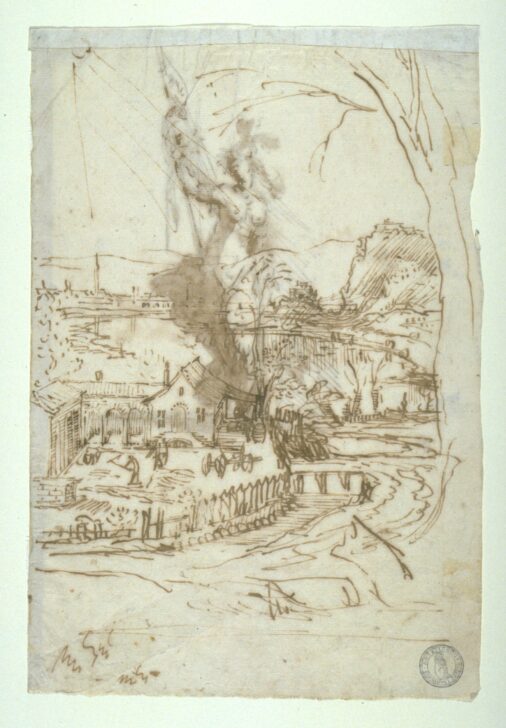Landscape View with Farm (recto) ; Standing Female Figure with SPQR Banner (verso)
Pozzoserrato

Description
In the first decades of the 16th century, Venetian artists began creating drawings and prints featuring only scenes of nature. This trend grew out of the interest in background landscapes in the paintings of Giovanni Bellini, Giorgione, and Titian (and, as seen here, in works by the lesser known Pietro degli Ingannati and a member of the circle of Giorgione). The present drawing stems from this tradition.
The double-sided sketch sheet has been attributed to Pozzoserrato, a Flemish painter of panoramas active in the Veneto in the late 16th century. The presence of farm workers in the scene indicates that it is not a "pastoral" (bucolic landscape with mythological figures or shepherds), like the Allegory produced in Giorgione's circle and exhibited here; rather it is in the tradition of Virgil's Georgics, which idealizes the labor of the land.
While the front of the sheet attests to this Flemish artist's interest in the naturalistic landscape tradition of the Veneto, the back of the study, showing a female figure with elongated proportions and a serpentine pose, reveals the influence of central Italian Mannerist conventions. The woman bears the standard of ancient Rome and may represent the goddess of war, Bellona.
Exhibition label text for "Venice, Traditions Transformed," September 21, 1996 - January 12, 1997 by Annette Dixon and Monika Schmitter.
Subject Matter:
The double-sided sketch sheet has been attributed to Pozzoserrato, a Flemish painter of panoramas active in the Veneto in the late 16th century. The presence of farm workers in the scene indicates that it is not a "pastoral" (bucolic landscape with mythological figures or shepherds), like the Allegory produced in Giorgione's circle and exhibited here; rather it is in the tradition of Virgil's Georgics, which idealizes the labor of the land.
While the front of the sheet attests to this Flemish artist's interest in the naturalistic landscape tradition of the Veneto, the back of the study, showing a female figure with elongated proportions and a serpentine pose, reveals the influence of central Italian Mannerist conventions. The woman bears the standard of ancient Rome and may represent the goddess of war, Bellona.
Usage Rights:
If you are interested in using an image for a publication, please visit https://umma.umich.edu/request-image/ for more information and to fill out the online Image Rights and Reproductions Request Form.